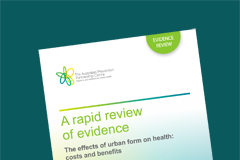The effects of urban form on health: costs and benefits
This report summarises recent Australian evidence, and uses modelling to estimate the economic value of specific changes in urban form in the Australian context.
Background
The Centre for Population Health of the NSW Ministry of Health commissioned a review to estimate the health-related economic value of changes in urban form that impact on physical activity. This review and modelling exercise will allow the Centre to provide other government departments with the information needed to include these health externalities in the development of cost-benefit analyses for land use planning.
Key messages
- Within the Australian context, there is sufficient evidence that increased walking and cycling have positive monetary health-related benefits.
- Each additional kilometre walked has been estimated to result in health-related benefits that range in value from $1.04 to $2.08. Each additional kilometre cycled results in health-related benefits that range in value from less than $0.02 to $1.12.
- There is compelling Australian evidence linking attributes of the urban form with physical activity among adults. There is insufficient evidence to draw conclusions for children and adolescents.
- Attributes of the urban form that increase physical activity among adults are the number of destinations within walking or cycling distance, greater diversity in land use, shorter distance to transit, and neighbourhood walkability. Broadly, the literature suggests that if people are to walk and cycle, they need destinations within walking or cycling distance.
- Economic outcomes were found to be greatest for increasing destinations within the neighbourhood, which are associated with health-related benefits worth an average $14.65 per adult annually (range $0.42 to $42.50), depending on the destination and context. The economic value of increasing neighbourhood walkability was found to be worth an average $1.62 per adult annually (range $0.11 to $15.73).
- The health-related economic benefits of changes in urban form are modest at an individual level, but when multiplied for whole populations, these figures are significant.
